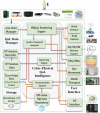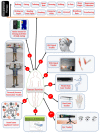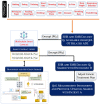A Secure Occupational Therapy Framework for Monitoring Cancer Patients' Quality of Life
- PMID: 31795384
- PMCID: PMC6928807
- DOI: 10.3390/s19235258
A Secure Occupational Therapy Framework for Monitoring Cancer Patients' Quality of Life
Abstract
Once diagnosed with cancer, a patient goes through a series of diagnosis and tests, which are referred to as "after cancer treatment". Due to the nature of the treatment and side effects, maintaining quality of life (QoL) in the home environment is a challenging task. Sometimes, a cancer patient's situation changes abruptly as the functionality of certain organs deteriorates, which affects their QoL. One way of knowing the physiological functional status of a cancer patient is to design an occupational therapy. In this paper, we propose a blockchain and off-chain-based framework, which will allow multiple medical and ambient intelligent Internet of Things sensors to capture the QoL information from one's home environment and securely share it with their community of interest. Using our proposed framework, both transactional records and multimedia big data can be shared with an oncologist or palliative care unit for real-time decision support. We have also developed blockchain-based data analytics, which will allow a clinician to visualize the immutable history of the patient's data available from an in-home secure monitoring system for a better understanding of a patient's current or historical states. Finally, we will present our current implementation status, which provides significant encouragement for further development.
Keywords: cyber-physical occupational therapy system; distributed medical big data; health IoT sensors; quality of life; therapeutic kinematic data.
Conflict of interest statement
The authors declare no conflict of interest.
Figures






















Similar articles
-
A Decentralized Privacy-Preserving Healthcare Blockchain for IoT.Sensors (Basel). 2019 Jan 15;19(2):326. doi: 10.3390/s19020326. Sensors (Basel). 2019. PMID: 30650612 Free PMC article.
-
Palliative care experiences of adult cancer patients from ethnocultural groups: a qualitative systematic review protocol.JBI Database System Rev Implement Rep. 2015 Jan;13(1):99-111. doi: 10.11124/jbisrir-2015-1809. JBI Database System Rev Implement Rep. 2015. PMID: 26447011
-
Towards a Remote Monitoring of Patient Vital Signs Based on IoT-Based Blockchain Integrity Management Platforms in Smart Hospitals.Sensors (Basel). 2020 Apr 13;20(8):2195. doi: 10.3390/s20082195. Sensors (Basel). 2020. PMID: 32294989 Free PMC article.
-
A Blockchain Framework for Patient-Centered Health Records and Exchange (HealthChain): Evaluation and Proof-of-Concept Study.J Med Internet Res. 2019 Aug 31;21(8):e13592. doi: 10.2196/13592. J Med Internet Res. 2019. PMID: 31471959 Free PMC article. Review.
-
A review: a new authentication protocol for real-time healthcare monitoring system.Ir J Med Sci. 2021 Aug;190(3):927-932. doi: 10.1007/s11845-020-02425-x. Epub 2020 Nov 3. Ir J Med Sci. 2021. PMID: 33145637 Review.
Cited by
-
Design and Implementation of Intelligent Monitoring System for Head and Neck Surgery Care Based on Internet of Things (IoT).J Healthc Eng. 2022 Feb 23;2022:4822747. doi: 10.1155/2022/4822747. eCollection 2022. J Healthc Eng. 2022. Retraction in: J Healthc Eng. 2023 Aug 9;2023:9806292. doi: 10.1155/2023/9806292. PMID: 35251567 Free PMC article. Retracted.
-
Information management research and practice in the post-COVID-19 world.Int J Inf Manage. 2020 Dec;55:102175. doi: 10.1016/j.ijinfomgt.2020.102175. Epub 2020 Jun 19. Int J Inf Manage. 2020. PMID: 32836635 Free PMC article.
-
Artificial Intelligence and Its Revolutionary Role in Physical and Mental Rehabilitation: A Review of Recent Advancements.Biomed Res Int. 2024 Dec 17;2024:9554590. doi: 10.1155/bmri/9554590. eCollection 2024. Biomed Res Int. 2024. PMID: 39720127 Free PMC article. Review.
-
Use Case Evaluation and Digital Workflow of Breast Cancer Care by Artificial Intelligence and Blockchain Technology Application.Healthcare (Basel). 2022 Oct 20;10(10):2100. doi: 10.3390/healthcare10102100. Healthcare (Basel). 2022. PMID: 36292547 Free PMC article.
References
-
- Tremmas I., Petsatodis G., Potoupnis M., Laskou S., Giannakidis D., Mantalovas S., Koulouris C., Katsaounis A., Pavlidis E., Amaniti A., et al. Monitoring changes in quality of life in patients with lung cancer under treatment with chemotherapy and co administration of zoledronic acid by using specialized questionnaires. J. Cancer. 2018;9:1731–1736. doi: 10.7150/jca.24785. - DOI - PMC - PubMed
-
- Shallwani S.M., King J., Thomas R., Thevenot O., De Angelis G., Ala’S A., Brosseau L. Methodological quality of clinical practice guidelines with physical activity recommendations for people diagnosed with cancer: A systematic critical appraisal using the AGREE II tool. PLoS ONE. 2019;14:e0214846. doi: 10.1371/journal.pone.0214846. - DOI - PMC - PubMed
-
- Strøm H.H., Bremnes R.M., Sundstrøm S.H., Helbekkmo N., Fløtten Ø., Aasebø U. Concurrent palliative chemoradiation leads to survival and quality of life benefits in poor prognosis stage III non-small-cell lung cancer: A randomised trial by the Norwegian Lung Cancer Study Group. Br. J. Cancer. 2013;109:1467–1475. - PMC - PubMed
MeSH terms
LinkOut - more resources
Full Text Sources

